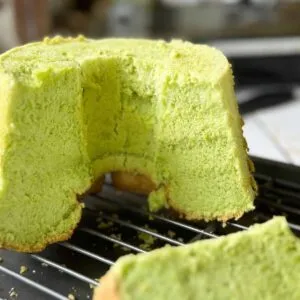Vietnamese pandan honeycomb cake (Bánh Bò Nướng) can be tricky, but after many tries, I’ve perfected a version I’m proud of.
It’s soft for days, fragrant, and nearly foolproof, without that bitter, metallic bite from too much baking powder.

What is Bánh Bò Nướng?
Bánh Bò Nướng, or Vietnamese Pandan Honeycomb Cake, gets its bright green color from pandan leaves—hence the name Bánh Bò Nướng Lá Dứa. Some call it “Vietnamese pandan cake” or simply “green cake.”
The name Bánh Bò has quirky origins: one story says the cake once resembled a cow’s udder, another points to the way it “crawls” upward as it bakes, forming its signature honeycomb.
A perfect cake is all about those rễ tre—the delicate bamboo-root lines running through every slice.
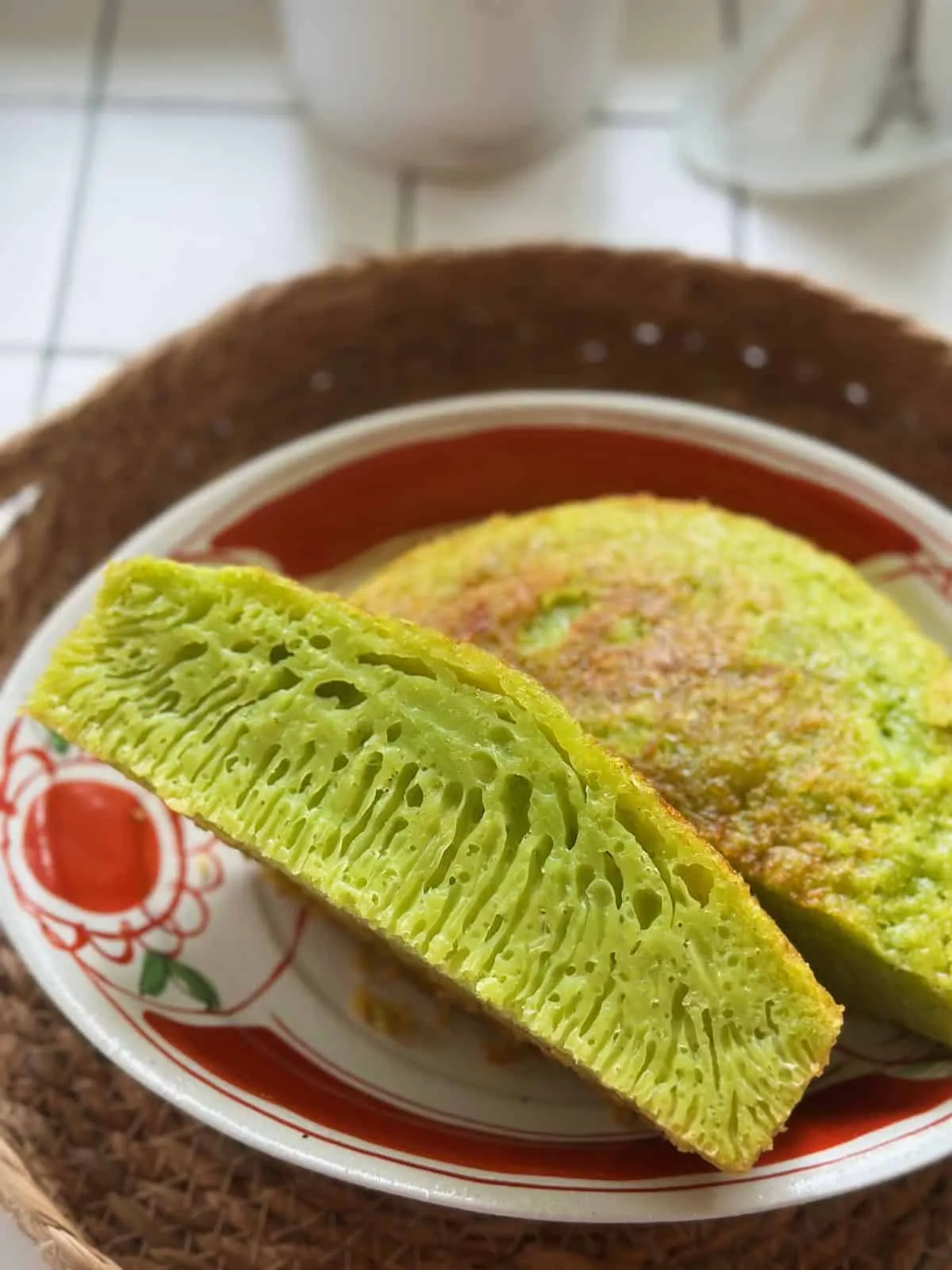
When we say Bánh Bò in Vietnam, most people think of the old-school rice-flour cakes—no eggs, just naturally risen with Cơm Rượu (sweet fermented rice) or sometimes yeast for a quicker rise.
The chewy pandan-and-egg version, now hugely popular, actually originated in Vietnamese diaspora kitchens before making its way back to the homeland.
Interestingly, here in the mainland, the Vietnamese honeycomb cake with palm sugar (Bánh Bò Nướng Đường Thốt Nốt) is even more famous than the green pandan one.
These days, Bánh Bò in Vietnam comes in many forms:
Bánh Bò Nướng – The traditional baked version made with rice, yeast, coconut milk, and coconut water — no eggs, fully vegan.
Bánh Bò Hấp (Steamed Bánh Bò) – The steamed counterpart, also made from rice, yeast, coconut milk, and coconut water, with no eggs.
Bánh Bò Nướng Nhân Dừa – A pan-baked “sandwich” style cake filled with sweet coconut.
Bánh Bò Bông – A steamed and extra airy version — the Vietnamese take on the Chinese Fa Gao (Prosperity Cake).
Bánh Bò Người Hoa (Chinese Bánh Bò) – Popular among the Chinese-Vietnamese community; essentially the Chinese white sugar sponge cake, Bai Tang Gao.
How I Developed This Recipe – And Why You’ll Love It
My first attempts at Bánh Bò Nướng? Total flop. I followed every step—gentle stirring, preheating, straining the batter—hoping for perfect rễ tre, but ended up with flat, eggy cakes and that bitter baking powder taste.
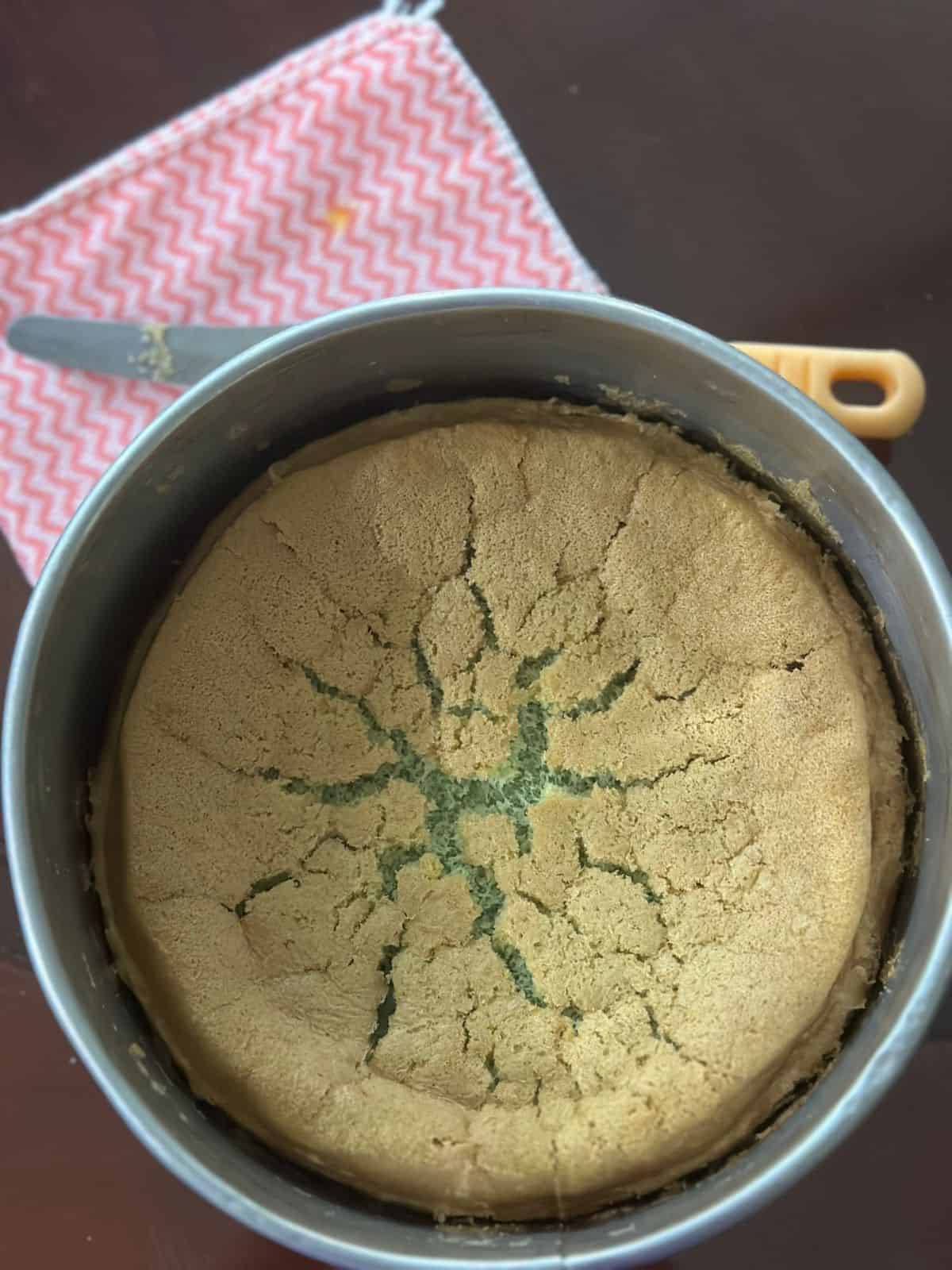
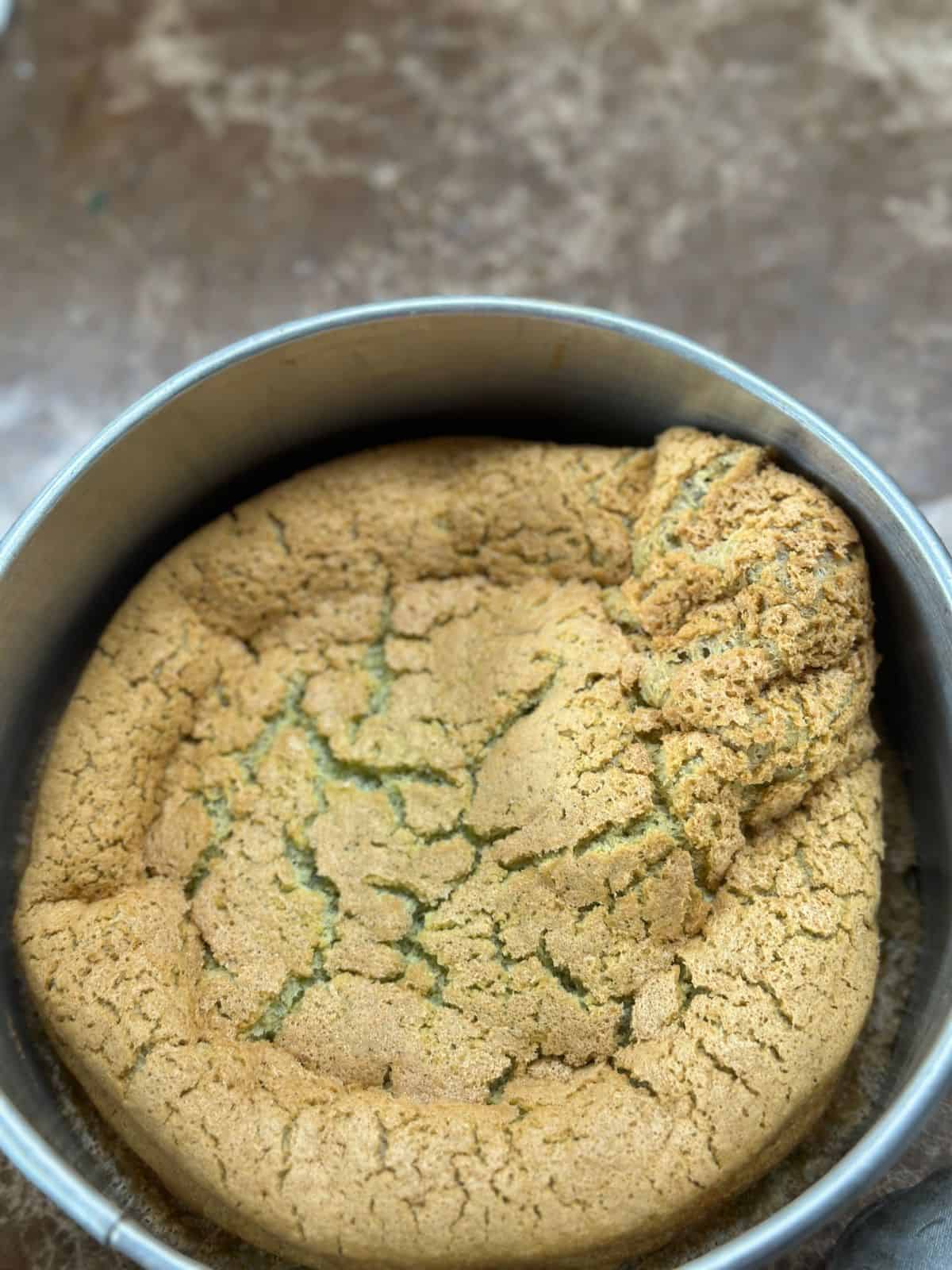
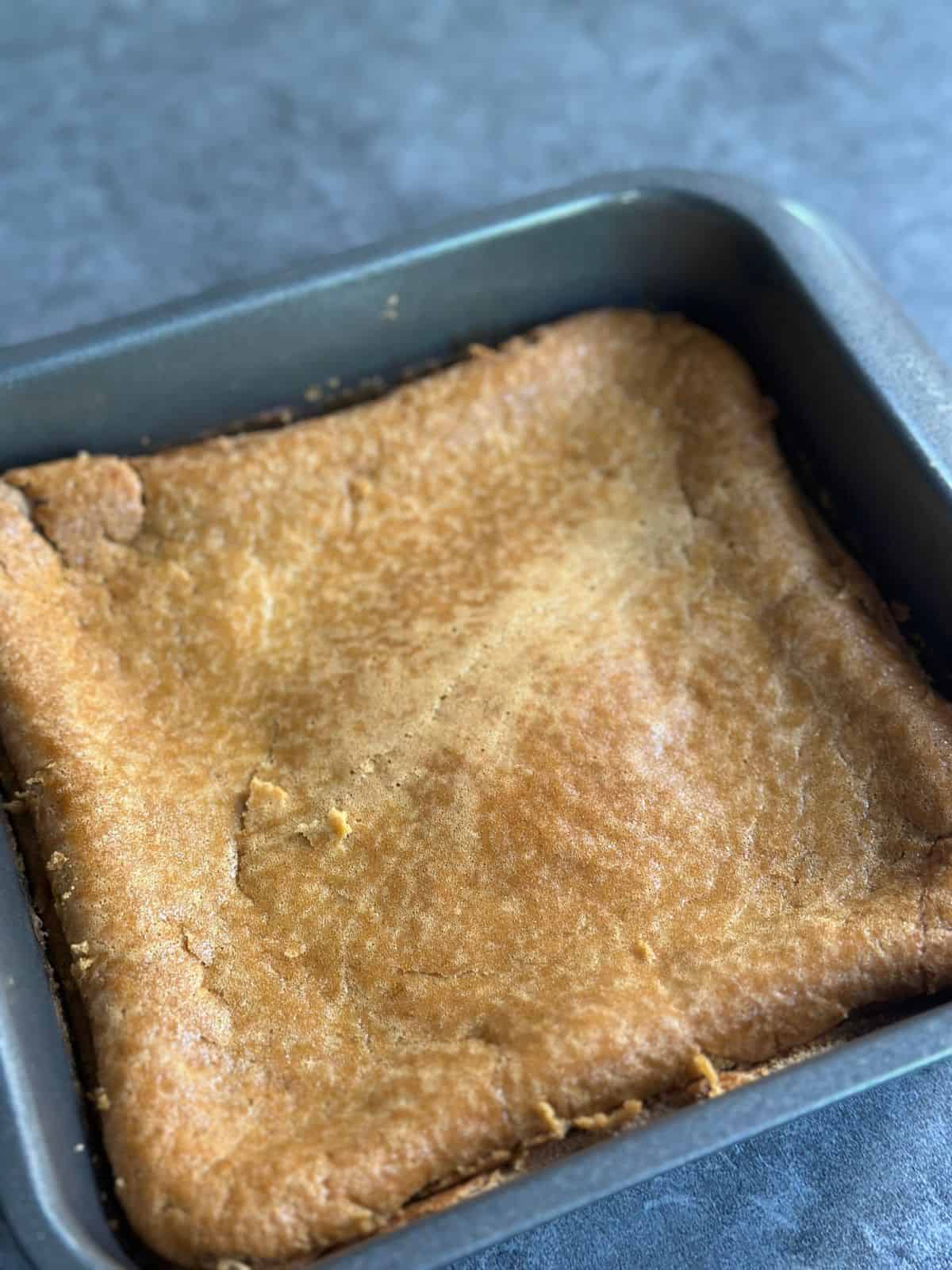
Pandan is trickier than palm sugar; baking soda ruins the color, so you’re stuck with baking powder… and its bitterness.
After many tries, I finally found the sweet spot: a mix of yeast and baking powder, combining traditional and modern methods.
The result? A beautifully risen cake, soft, chewy, fragrant, and perfectly green. Letting the batter rest for an hour adds a deeper, rounded flavor. From here, you can even experiment with flavors like Ube honeycomb cake!

Related Recipes | Discover More Delicious Pandan-Flavored Desserts:
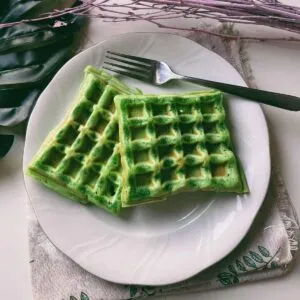
(Bánh Kẹp Lá Dứa)

(Bánh Da Lợn)

(Xôi Lá Dứa)
Ingredients
- Tapioca Starch: Essential for the cake’s signature chewy texture.
- All-Purpose Flour: Adds softness, keeping the cake tender even after a day. For a gluten-free version, you can substitute with rice flour or additional tapioca starch.
- Instant Yeast (or Active Dry Yeast): A key ingredient for leavening.
- Baking Powder: Both single-acting and double-acting work well in this recipe.
- Full-Fat Coconut Milk: Adds the rich coconut flavor typical of Bánh Bò. If you prefer a milder coconut taste, you can replace half with whipping cream.
- Pandan Leaves & Artificial Pandan Extract: for both fragrance and color but you can use either one
- Eggs (size M)
- Granulated Sugar
- Salt
- Melted Coconut Oil (or Melted Butter)
- Vanilla Extract: Optional.
Instructions
Step 1 – Activate the Yeast
- Dissolve the yeast in warm water with 1 tablespoon of granulated sugar. Let it sit for 15 minutes until foamy and bubbly, indicating the yeast is active.
Step 2 – Prepare the Pandan-Coconut Milk Mixture
- Blend the green part of pandan leaves with coconut milk (slightly warm the coconut milk if it has solidified or curdled).
- Strain through a fine mesh to obtain pandan-infused coconut milk, adding more coconut milk to reach the amount required (170 g). Stir in the remaining sugar, salt, and pandan flavoring (if using).
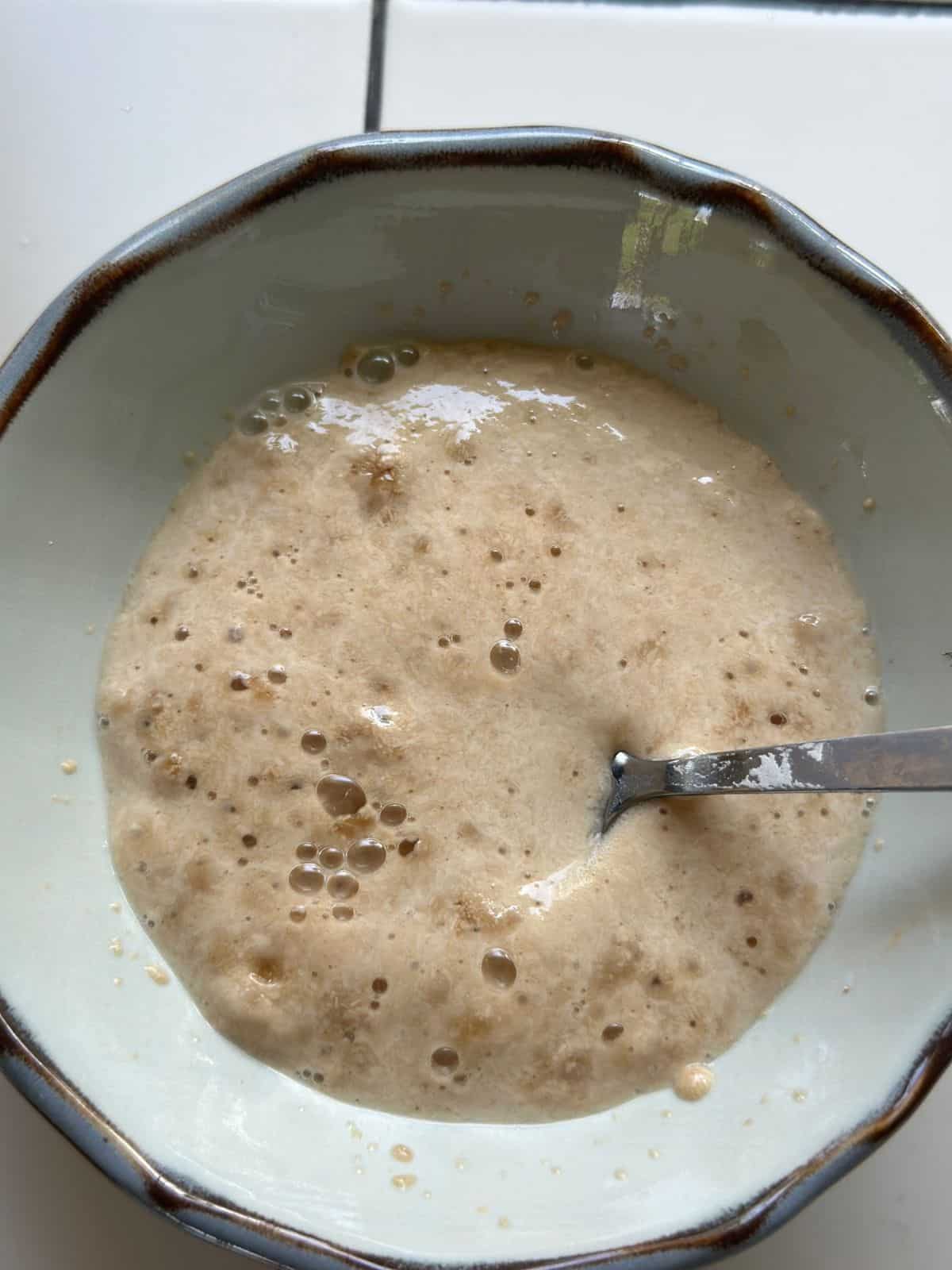
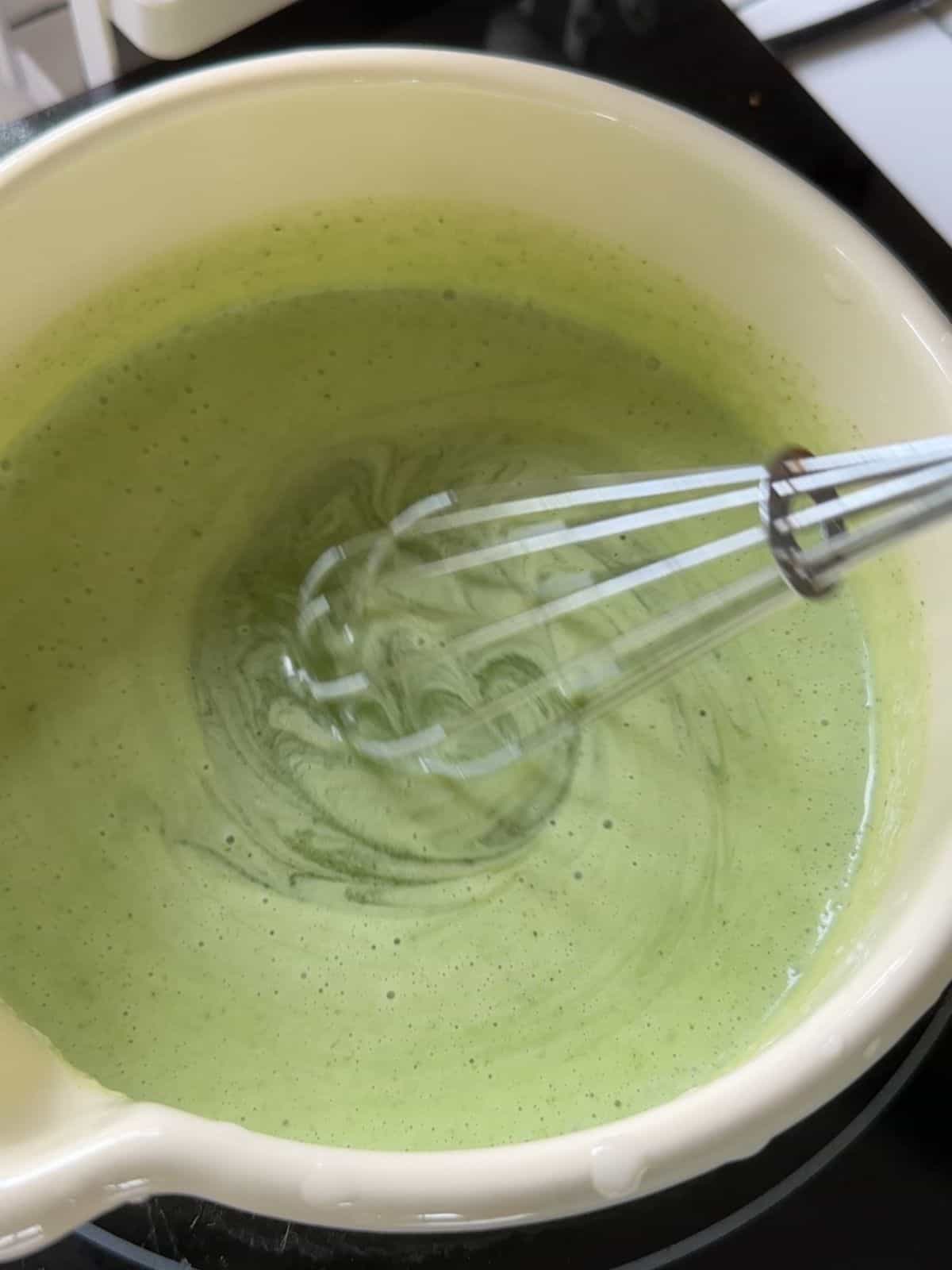
Step 3 – Make the Batter Base
- In a separate bowl, whisk together tapioca starch, all-purpose flour, and eggs until smooth. Add the pandan-coconut milk mixture and mix well (you can also use a food processor or blender).
- Strain the mixture to remove any lumps, then fold in the yeast mixture.
Step 4 – Ferment the Batter
- Cover and let rest for 1 hour in a warm environment (about 86°F/30°C). In cooler climates, keep it in the oven with the light on.
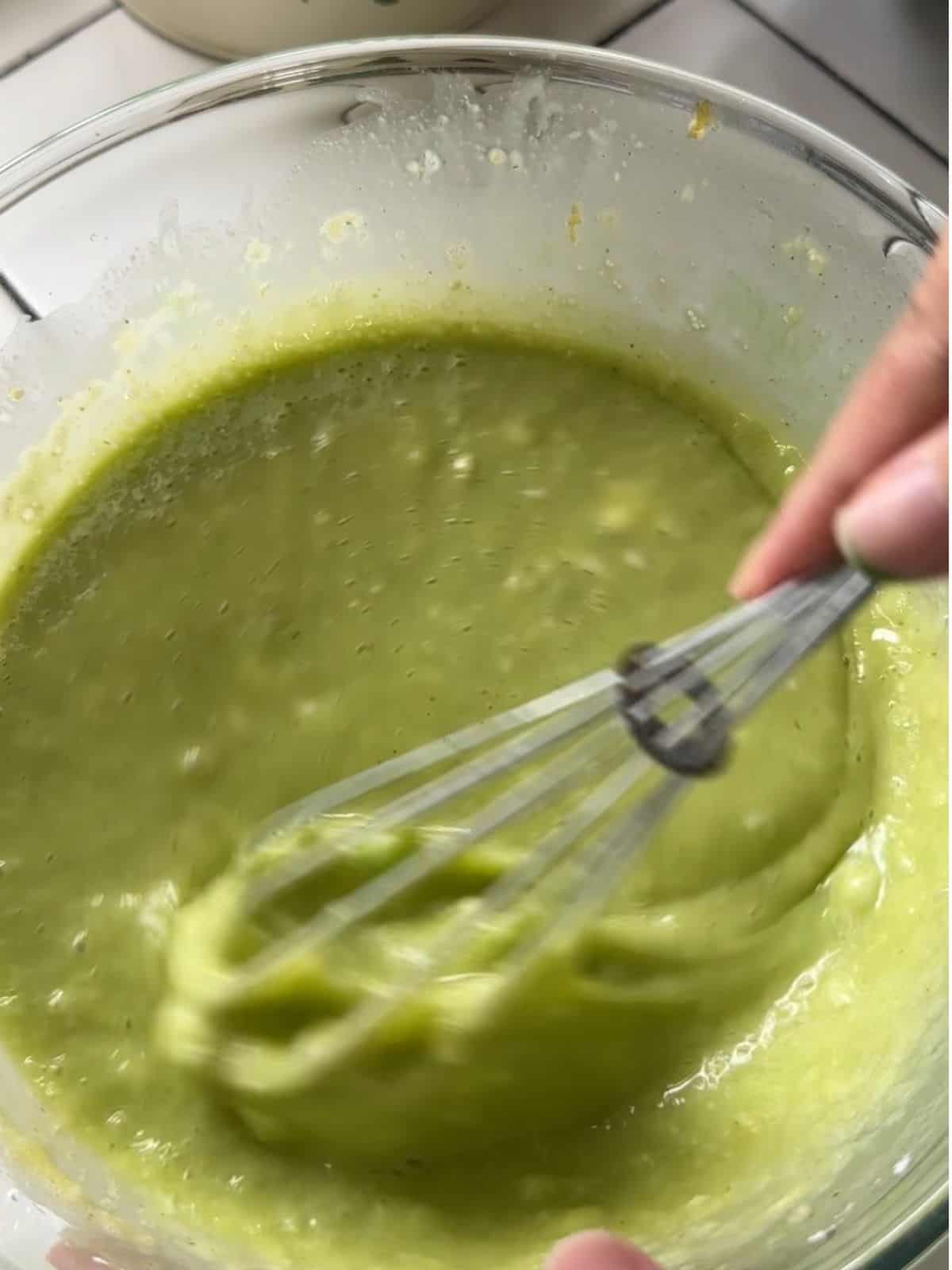

Step 5 – Add Final Ingredients
- After fermentation, stir in melted coconut oil (or melted butter) and baking powder, then strain again for a smooth texture.
- Grease the mold thoroughly, pour in the batter.
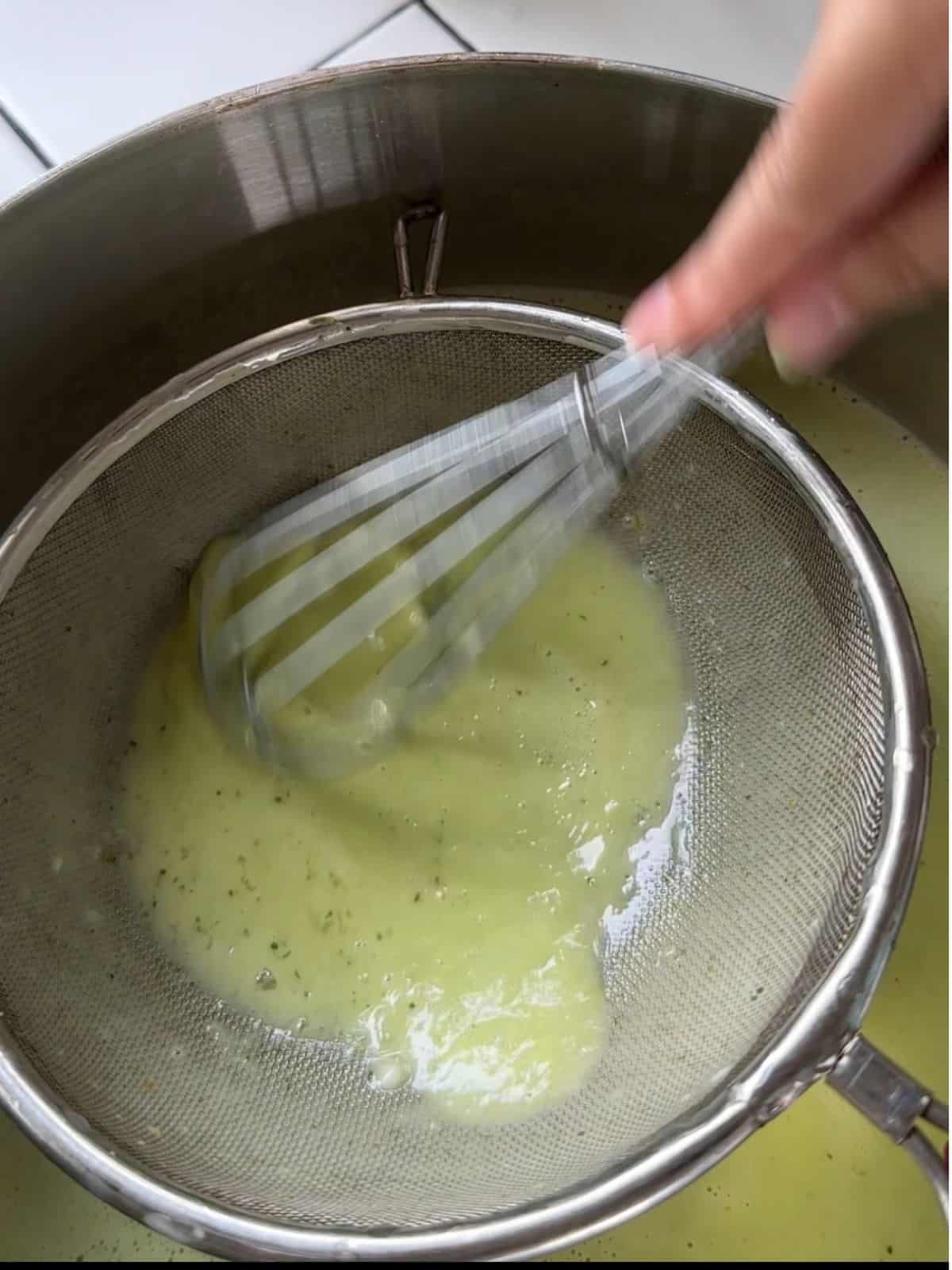
Step 6 – Bake the Cake
- At 355°F (180°C, no fan): Preheat the oven for at least 20 minutes. The batter should go in right after it’s ready, so plan your timing well. Place the cake on the second rack, keep the top heat off (or cover the mold with foil), and bake for 15 minutes.
- Reduce to 265°F (130°C): Remove the foil (or turn on both top and bottom heat) and continue baking for 30 minutes.
- Increase back to 355°F (180°C): Bake another 10–15 minutes until golden. You can move the cake to the top rack for this step—just be quick!
- Cool completely before unmolding to prevent sticking.

Expert Tips
Bottom heat is key: Bottom heat bakes the cake; top heat only browns it. For the first 15 minutes, stick to bottom heat—cover with foil or turn off the top heat if needed.
Greasing and Cooling: Grease the pan thoroughly and let the cake cool completely before removing it, as this makes it easier to release without sticking.
Check your baking powder and yeast: Both double-acting and single-acting types work—no need for Alsa. Just make sure they’re fresh and active for the best rise and honeycomb texture.
Adjusting Color: If you’re using just artificial pandan flavor and prefer a more natural green color, add a few drops of yellow food coloring. This balances the neon green, creating a softer, natural-looking hue.
Measure with a kitchen scale: Honeycomb cake needs precision. Too much liquid can make the batter runny and cause it to shrink after baking. If your eggs are extra large, remove a bit of the egg white.
Serving Suggestion: Enjoy this pandan honeycomb cake on its own or pair it with Vietnamese sweetened coconut sauce for added flavor.
Optional Steps: Here are some optional steps to try if you’re still struggling to get the right texture (I usually skip these and still get great results):
- Preheating the pan for 3-5 minutes before pouring the batter.
- Use a bundt pan with simple design. Its central tube promotes even heat distribution.
- After baking, flip the cake (while still in the pan) upside down and let it cool for 15-20 minutes.
FAQs
More traditional Vietnamese desserts
Vietnamese Steamed Banana Cake (Bánh Chuối Hấp)
Vietnamese Banana Cake (Bánh Chuối Nướng)
Vietnamese Mung Bean Cake (Bánh Đậu Xanh Nướng)
Vietnamese Cassava Cake (Bánh Khoai Mì Nướng)
Vietnamese Flan (Bánh Flan)
Vietnamese Yogurt (Sữa Chua)
Avocado Smoothie (Sinh Tố Bơ)
Chikoo Shake (Sinh Tố Sapoche)

No-Fail Pandan Honeycomb Cake (Banh Bo Nuong)
Equipment
- 1 round baking pan (7-8 inch diameter or 18-20 cm)
Ingredients
I highly recommend using a kitchen scale to measure.
- 200 g tapioca starch
- 10 g all-purpose flour (or rice flour or tapioca starch)
- 5 eggs (Size M)
- 170 g coconut milk (full-fat)
- 170 g granulated sugar
- 10 g melted coconut oil (or melted butter) (about ⅔ tbsp)
- 30 g luke warm water (100–110°F/38–43°C)
- 3 g baking powder (⅔ tsp)
- 3 g instant yeast (active dry yeast) (1 tsp)
- ¼ tsp salt
- 7 pandan leaves (fresh or defrosted) (You can use either pandan leaves, pandan extract, or both.)
- ¼ tsp pandan flavoring extract
- ½ tsp vanilla extract (optional)
Instructions
- Activate the Yeast: Dissolve the yeast in lukewarm water with 1 tbsp sugar. Let it sit for 15 minutes until it becomes foamy and bubbly, indicating that it's active.
- Make the Pandan-Coconut Milk Mixture: Blend the green part of pandan leaves with coconut milk (warm it slightly if it’s solidified or curdled). Strain through a fine mesh to get pandan-infused coconut milk, then top up with more coconut milk to reach 170 g. Stir in the remaining sugar, salt, and pandan flavoring (if using).
- Prepare the Batter: In a separate bowl, whisk together tapioca starch, all-purpose flour, and eggs until smooth. Add the pandan-coconut milk mixture and stir to combine. (You could use food processor or a blender to mix everything).
- Combine and Ferment: Strain the mixture to remove any lumps, then fold in the yeast mixture. Cover the bowl and let it rest for 1 hour (I keep mine at 86°F/30°C). In cooler climates, place the batter in the oven with the light on to maintain a warm environment.
- Add Final Ingredients: After 1 hour, stir in the melted coconut oil (or melted butter), then add the baking powder. Strain the batter again to ensure it's smooth. Grease your baking mold thoroughly with oil and pour in the batter.
- Bake the Cake: – Bake immediately after preparing. Be sure to preheat the oven to 355°F (180°C) (no fan) 20 minutes before baking.– Place the cake on the second rack, keeping the top heat off (or cover with foil), and bake for 15 minutes at 355°F (180°C).– Quickly remove the foil (or switch to both top and bottom heat if you have turned off the top heat), then reduce the temperature to 265°F (130°C) and bake for another 30 minutes.– Finally, increase the temperature to 355°F (180°C) and bake for an additional 10–15 minutes until the top is golden brown. You can move the cake to the top rack at this stage — just be quick!
- Cool and Unmold: Let the cake cool completely before removing it from the pan. Since Bánh Bò Nướng is sticky, cooling it fully makes it easier to take out.

